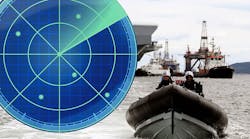Small boats operating in littoral regions close to shore often need to perform search and track functions, using a radar with antenna masts of limited height. The low mast heights can limit the range of the radar, as does a need to maintain low-power operating in military applications for low probability of intercept (LPI).
Fortunately, a trio of researchers from the Department of Electrical and Computer Engineering of the Naval Postgraduate School (Monterey, Calif.) developed a low-power continuous-wave (CW) bistatic radar system in which transmit and receive actions take place at the same time. Part of their novel system solution was the development of an omnidirectional transmit antenna and digitally patterned receive antenna, operating continuously with simultaneous transmit and receive functions.
For operators of small marine vessels hoping to remain covert, this radar system design promises good coverage without doubling as a beacon for threat surveillance systems. It features closely spaced antenna elements to fit the antennas on a small mast. The receive antennas follow digitally controlled, overlapping receive patterns for continuous reception. Meanwhile, the transmitter uses a phase-coding technique to allow for close placement of the transmit antenna elements with the receive antenna elements without causing interference from transmitter signal leakage.
Since possible beamwidth will change with the number of antenna elements, the arrays were designed with large numbers of antenna elements. Wideband H-plane sectoral horns were used as the antenna elements for an experimental design, for both transmit and receive functions, because they can be closely spaced and suffer low signal loss compared to miniature microstrip antenna elements. The horns cover a frequency range of 18.0 to 26.5 GHz.
For ease of mast mounting, the arrays were formed in cylindrical configurations of vertical elements. Elements were switched as needed, for example, to form 90-deg. vertical azimuth receiving patterns when the antenna had a line-of-sight view of an illuminated target. Design simulations show the potential of this system for effective search and track functions for small boats close to shore, whether for commercial or military applications.
See “An Antenna for a Mast-Mounted Low Probability of Intercept Continuous Wave Radar,” IEEE Antennas & Propagation Magazine, April 2019, pp. 63-70.

